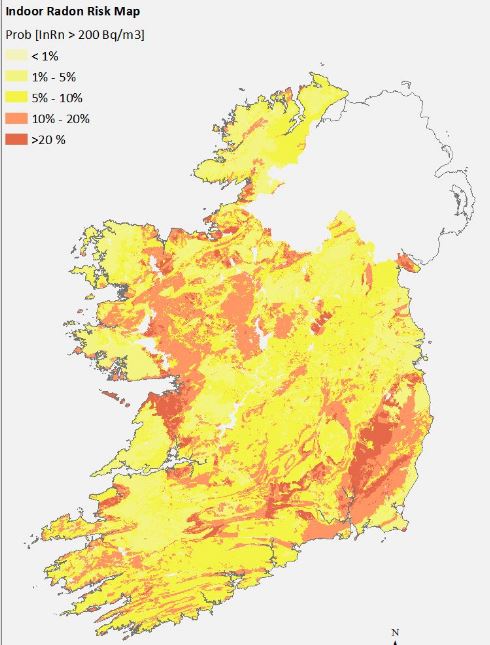Scientists produce new map showing areas at risk from radon gas
Up to 460,000 people in the State – one in 10 of the population – are at risk from unsafe exposure to indoor radon gas, which may cause lung cancer.
A new radon risk map published by scientists at Trinity College Dublin shows that about 10 per cent of the population is exposed to radon that exceeds maximum recommended levels.
 |
Radon is a natural radioactive gas present in all soils and is the principal source of radiation exposure, making up 56 per cent of the overall dose in Ireland.
Exposure increases the likelihood of developing lung cancer, and causes about 250 deaths from lung cancer here each year – a higher number of fatalities than is caused by road traffic accidents.
The new radon risk map illustrates the same general categories, but does so at a different spatial scale, which makes it easier to identify regional or local variations in radon risk.
The south-east and west of Ireland are prominent regions for high risk, according to the map, but it indicates that homes with high radon could potentially be found in any county, the scientists say.
Some areas at high risk would previously not have been categorised as such, according to the geologists. The researchers urged people to have their homes tested for radon.
The new map divides the Republic into three main radon risk areas: low, medium and high, with probabilities of having an indoor radon concentration above the reference level.
The total population in the low risk areas is 1.08 million (24 per cent) and in the medium risk areas 2.13 million (46 per cent).
Some 30 per cent of the population, or 1.37 million people, live in a high-risk area for radon.
Prof Quentin Crowley, assistant professor in isotopes and the environment at the School of Natural Sciences at Trinity College Dublin said the new high spatial resolution radon risk map was a “big improvement” on the previous map.
The researchers found that including geological data, such as bedrock and glacial geology, subsoil permeability and sub-surface permeability in relation to groundwater with existing indoor radon concentration measurements provided a more detailed picture of the radon risk facing the public.
Prof Crowley said, however, it was not possible to provide a level of detail on risk areas by town, or city, for example. The only way of knowing whether a particular home or building was at risk was to have it tested.
“We have some of the highest recorded indoor levels of radon in Europe and probably the eighth highest globally,” Prof Crowley said.
There had been some reduction in the levels here due to the work carried out by the Environmental Protection Agency to urge people to test their homes.
“Ireland does have a problem with radon and the more we can promote that testing the better,” Prof Crowley added.
“EU member states need to translate European radiation protection legislation into national law, and this requires an accurate definition of radon-prone areas. Our research provides one example of how national-scale radon risk maps can be produced, which is especially relevant to countries developing their national radon programmes.”
Javier Elío, researcher in the School of Natural Sciences at Trinity said the geologists estimated that 19 per cent of homes in high risk areas will have indoor radon concentrations higher than the national reference level, and that remedial action should be taken.
Barbara Rafferty of the Environmental Protection Agency, said no model – no matter how sophisticated – could substitute for having indoor radon levels tested.
“For this reason we advise all householders to test their homes for radon and, if high levels are found, to have their houses fixed. Further information is available on radon.ie”
Author: Elaine Edwards, The Irish Times
Source: http://www.irishtimes.com/news/environment/460-000-people-at-risk-from-cancer-causing-radon-gas-1.3093291
MEMTECH REINFORCED RADON BARRIER
Memtech R1 radon barrier is a low-density polyethylene membrane reinforced with a polypropylene reinforcing grid. It provides an effective barrier to the passage of liquid water and water vapour from the ground, as well as resistance to underground gases — Memtech R1 is capable of restricting the ingress of radon, methane and carbon dioxide gases into the building. It has a high resistance to puncture.
Memtech R1 is a four layer product, it is red in colour on the top side and black on the bottom side. Suitable for use in areas where carbon dioxide, methane and radon are present in the ground.
Laydex can provide the complete radon protection system, check-out more details here.





